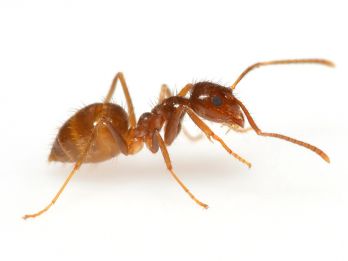Tawny (rasberry) crazy ant
Tawny crazy ants are an invasive species causing problems due to:
- a rapidly expanding range
- explosive localised population growth
- difficulty controlling populations.
Background
The ant identified as Nylanderia fulva (formerly Nylanderia sp. nr. pubens), with the common name tawny crazy ant, was formerly known as rasberry crazy ant.
It has developed into a significant pest in the south-eastern United States.
Impacts
Tawny crazy ants can reach extraordinary population densities, displaying super colony (unicolonial) behaviour.
During spring, foraging activity begins and colonies produce a dense worker load that increases dramatically by mid-summer. Ant numbers remain high through autumn. Few worker ants forage during cooler winter months.
Tawny crazy ants do not have stingers. Instead, worker ants possess an acidopore on the end of the gaster (abdomen), which can excrete chemicals for defence or attack. They are capable of biting, which causes a minute pain that quickly fades.
Identification
Tawny crazy ants are social insects that live in large groups, which seem to be indistinguishable from one another.
Colonies contain many queen ants, worker ants, and brood consisting of larval and pupal stages. Pupae are 'naked', without cocoons.
They periodically produce winged male and female forms called swarmers, alates, or reproductives.
Behaviour
Tawny crazy ant foraging trails are quite apparent (≥10 cm wide) and individuals forage erratically.
They avoid unshaded areas and are found:
- going up and down trees or fences
- following seams in concrete surfaces or structural barriers
- in large open grassy space.
Tawny crazy ants eat almost any organic material; they are omnivorous. Workers are attracted to sweet parts of plants, including nectaries or damaged and over-ripe fruit. They also consume other insects and small vertebrates for protein.
Worker ants commonly 'tend' sucking hemipterous insects, such as aphids, scale insects, whiteflies, and mealy bugs. These excrete a sugary carbohydrate liquid called honeydew, when stimulated by the ants.
Habitat
Colonies are found under or within almost any object or void that retains moisture, including stumps, soil, concrete, rocks, potted plants, etc.
Nests primarily occur outdoors, but worker ants will forage indoors, into homes and other structures.

